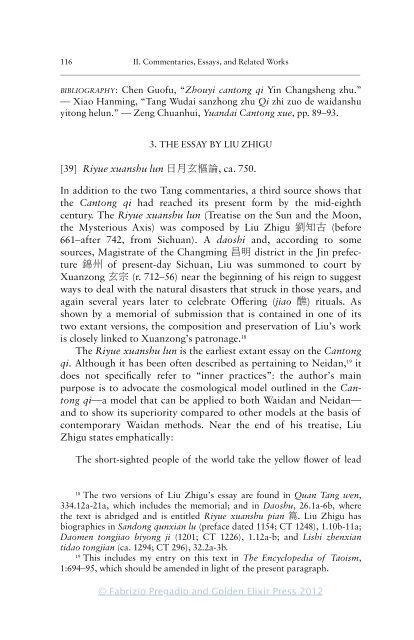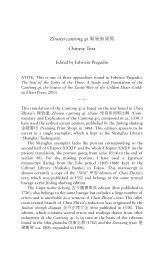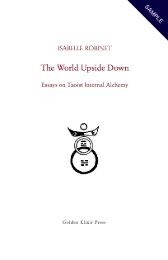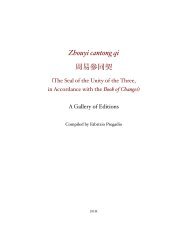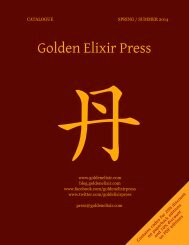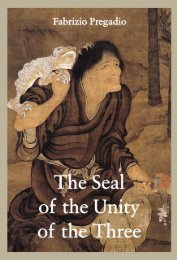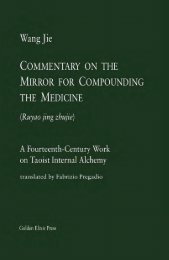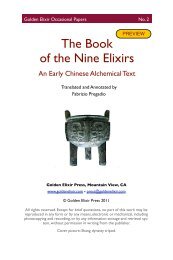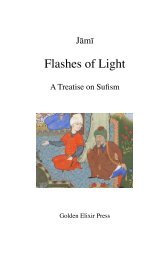The Seal of the Unity of the Three â Vol. 2 - The Golden Elixir
The Seal of the Unity of the Three â Vol. 2 - The Golden Elixir
The Seal of the Unity of the Three â Vol. 2 - The Golden Elixir
- No tags were found...
You also want an ePaper? Increase the reach of your titles
YUMPU automatically turns print PDFs into web optimized ePapers that Google loves.
116 II. Commentaries, Essays, and Related Works<br />
—————————————————————————————————————————<br />
BIBLIOGRAPHY: Chen Gu<strong>of</strong>u, “Zhouyi cantong qi Yin Changsheng zhu.”<br />
— Xiao Hanming, “Tang Wudai sanzhong zhu Qi zhi zuo de waidanshu<br />
yitong helun.” — Zeng Chuanhui, Yuandai Cantong xue, pp. 89–93.<br />
3. THE ESSAY BY LIU ZHIGU<br />
[39] Riyue xuanshu lun 日 月 玄 樞 論 , ca. 750.<br />
In addition to <strong>the</strong> two Tang commentaries, a third source shows that<br />
<strong>the</strong> Cantong qi had reached its present form by <strong>the</strong> mid-eighth<br />
century. <strong>The</strong> Riyue xuanshu lun (Treatise on <strong>the</strong> Sun and <strong>the</strong> Moon,<br />
<strong>the</strong> Mysterious Axis) was composed by Liu Zhigu 劉 知 古 (before<br />
661–after 742, from Sichuan). A daoshi and, according to some<br />
sources, Magistrate <strong>of</strong> <strong>the</strong> Changming 昌 明 district in <strong>the</strong> Jin prefecture<br />
錦 州 <strong>of</strong> present-day Sichuan, Liu was summoned to court by<br />
Xuanzong 玄 宗 (r. 712–56) near <strong>the</strong> beginning <strong>of</strong> his reign to suggest<br />
ways to deal with <strong>the</strong> natural disasters that struck in those years, and<br />
again several years later to celebrate Offering (jiao 醮 ) rituals. As<br />
shown by a memorial <strong>of</strong> submission that is contained in one <strong>of</strong> its<br />
two extant versions, <strong>the</strong> composition and preservation <strong>of</strong> Liu’s work<br />
is closely linked to Xuanzong’s patronage. 18<br />
<strong>The</strong> Riyue xuanshu lun is <strong>the</strong> earliest extant essay on <strong>the</strong> Cantong<br />
qi. Although it has been <strong>of</strong>ten described as pertaining to Neidan, 19 it<br />
does not specifically refer to “inner practices”: <strong>the</strong> author’s main<br />
purpose is to advocate <strong>the</strong> cosmological model outlined in <strong>the</strong> Cantong<br />
qi—a model that can be applied to both Waidan and Neidan—<br />
and to show its superiority compared to o<strong>the</strong>r models at <strong>the</strong> basis <strong>of</strong><br />
contemporary Waidan methods. Near <strong>the</strong> end <strong>of</strong> his treatise, Liu<br />
Zhigu states emphatically:<br />
<strong>The</strong> short-sighted people <strong>of</strong> <strong>the</strong> world take <strong>the</strong> yellow flower <strong>of</strong> lead<br />
18<br />
<strong>The</strong> two versions <strong>of</strong> Liu Zhigu’s essay are found in Quan Tang wen,<br />
334.12a-21a, which includes <strong>the</strong> memorial; and in Daoshu, 26.1a-6b, where<br />
<strong>the</strong> text is abridged and is entitled Riyue xuanshu pian 篇 . Liu Zhigu has<br />
biographies in Sandong qunxian lu (preface dated 1154; CT 1248), 1.10b-11a;<br />
Daomen tongjiao biyong ji (1201; CT 1226), 1.12a-b; and Lishi zhenxian<br />
tidao tongjian (ca. 1294; CT 296), 32.2a-3b.<br />
19<br />
This includes my entry on this text in <strong>The</strong> Encyclopedia <strong>of</strong> Taoism,<br />
1:694–95, which should be amended in light <strong>of</strong> <strong>the</strong> present paragraph.<br />
© Fabrizio Pregadio and <strong>Golden</strong> <strong>Elixir</strong> Press 2012


